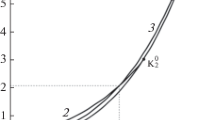Abstract
It is shown that the Ornstein-Zernike equation has two solutions, classic (analytic) and critical (not analytic). Closure equations of the HNC, PY, etc. types well known in the theory of liquids correspond to the first solution. The second solution presupposes that the bridge functional of a system has the form of the sum B = B rg + B cr, where B rg is a regular (analytic) function of density and B cr is a critical (not analytic) function. It is shown the classic solution determines the coordinates of the critical point, critical amplitudes, and the other parameters of critical phenomena depending on the individual liquid characteristics. The critical solution determines the critical indices and the equations relating them. The regions in which classic and critical solutions are valid are separated on the phase plane by a line of singular points, at which the second derivatives of pressure experience discontinuity.
Similar content being viewed by others
References
M. Barmatz, J. Hahn, J. A. Lipa, and R. V. Duncan, Rev. Mod. Phys. 79(1) (2007).
G. A. Martynov, J. Chem. Phys. 129, 244509 (2008).
G. A. Martynov, Phys. Rev. (in press).
C. Domb, The Critical Point (Taylor Fracis, London, 1996).
D. Yu. Ivanov, Critical Behavior of Non-Ideal Systems (Wiley-VCH, 2008).
R. Balesku, Equilibrium and Nonequilibrium Statistical Mechanics (Wiley, New York, 1978; Mir, Moscow, 1978), Vol. 1.
A. Parola and L. Reatto, Adv. Phys. 44, 211 (1995).
D. Pini, G. Stell, and N. B. Wilding, Mol. Phys. 95, 483 (1998).
I. S. Höye, D. Pini, and G. Stell, Phys. A 279, 213 (2000).
D. Pini and G. Stell, Phys. A 306, 270 (2002).
G. A. Martynov, Fundamental Theory of Liquids (Adam Hilger, Bristol, Philadelphia, New York, 1992).
M. A. Anisimov, V. A. Rabinovich, and V. V. Sychev, Thermodynamics of Critical State of Individual Substances (Energoatomizdat, Moscow, 1990) [in Russian].
E. M. Apfelbaum, V. S. Vorob’ev, and G. A. Martynov, J. Chem. Phys. 127, 064507 (2007).
I. Charpentier and N. Jakse, J. Chem. Phys. 123, 204910 (2005).
R. J. Baxter, J. Chem. Phys. 49, 2770 (1968).
S. Fishman and M. Fisher, Physica A 106, 1 (1981).
Yu. E. Gorbatyi and G. V. Bondarenko, Sverkhkritich. Flyuidy, Teor. Prakt. 2(2), 5 (2007).
Author information
Authors and Affiliations
Corresponding author
Additional information
Original Russian Text © G.A. Martynov, 2009, published in Zhurnal Fizicheskoi Khimii, 2009, Vol. 83, No. 10, pp. 1847–1860.
Rights and permissions
About this article
Cite this article
Martynov, G.A. Critical phenomena in liquids (theory). Russ. J. Phys. Chem. 83, 1665–1677 (2009). https://doi.org/10.1134/S0036024409100070
Received:
Published:
Issue Date:
DOI: https://doi.org/10.1134/S0036024409100070



